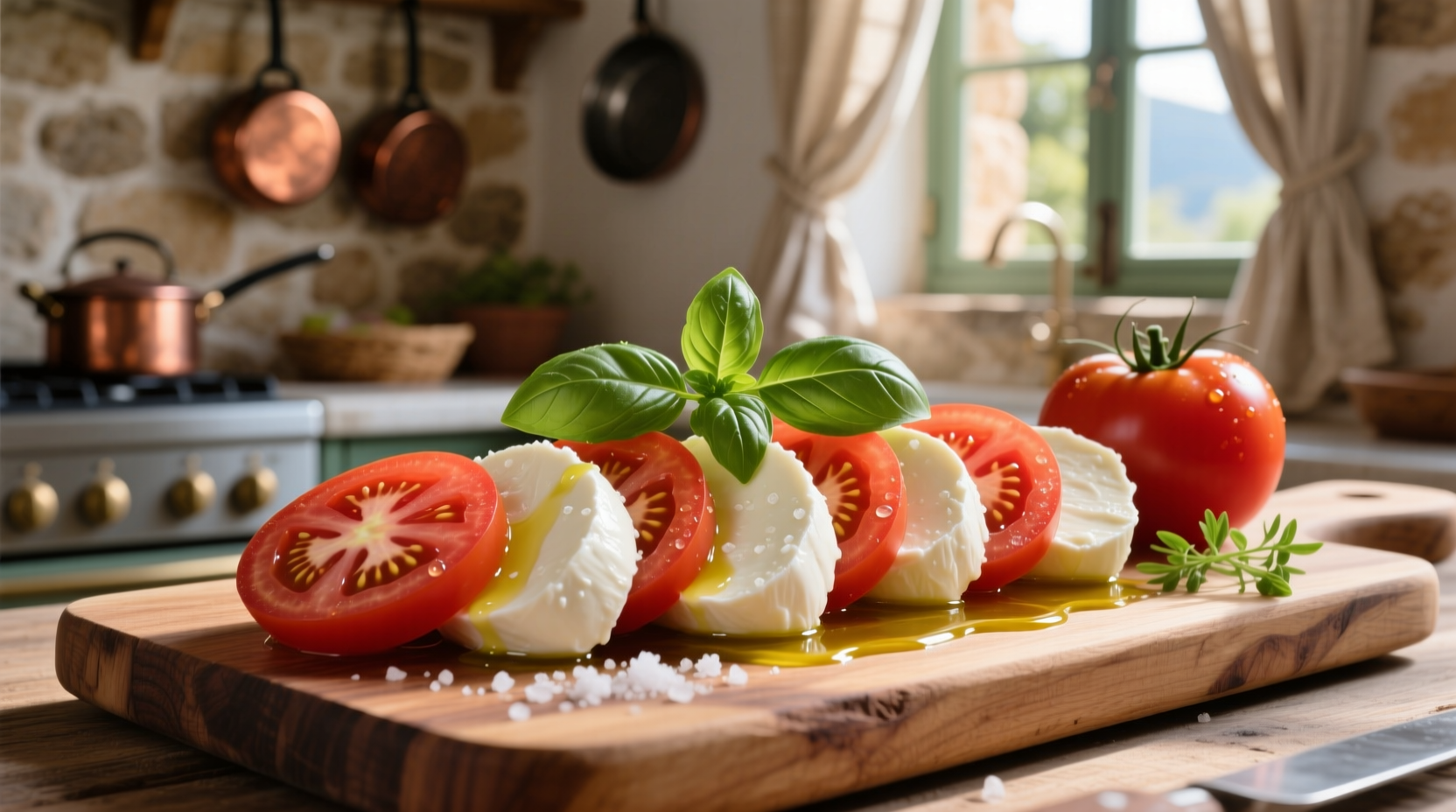The perfect tomato mozzarella pairing creates a classic Caprese salad that balances sweet acidity with creamy richness. Use vine-ripened tomatoes and fresh buffalo mozzarella with extra virgin olive oil, basil, and flaky sea salt for authentic results. This combination works best in summer when tomatoes reach peak flavor and acidity levels complement the cheese's mild tang.
When you're searching for the ideal tomato mozzarella combination, you're likely planning a summer meal that celebrates fresh ingredients. As a chef who's worked with these ingredients in Michelin-starred kitchens and casual settings alike, I've discovered the precise elements that transform this simple pairing into something extraordinary. The magic happens when perfectly ripe tomatoes meet high-quality mozzarella—the sweet acidity cuts through the cheese's richness while the creamy texture balances the fruit's juiciness.
Why This Pairing Works: The Science Behind Tomato Mozzarella Harmony
Understanding the chemistry between tomatoes and mozzarella explains why this combination has endured for centuries. Tomatoes contain glutamic acid, which enhances savory flavors, while mozzarella's casein proteins create a smooth mouthfeel that carries tomato acidity beautifully. The pH balance is critical—ripe tomatoes (pH 4.3-4.9) complement fresh mozzarella (pH 5.0-5.2) without overwhelming either component.
| Tomato Variety | Acidity Level | Best Mozzarella Match | Peak Season |
|---|---|---|---|
| San Marzano | Medium | Buffalo mozzarella | July-September |
| Beefsteak | Low | Fior di latte | June-August |
| Cherry | High | Stracciatella | May-October |
| Heirloom | Variable | Smoked mozzarella | July-September |
Selecting Premium Ingredients: What Most Home Cooks Miss
Supermarket tomatoes often disappoint because they're picked unripe for shipping. For authentic tomato mozzarella preparations, seek out vine-ripened varieties at farmers markets. Look for tomatoes with slight give when gently squeezed and deep, uniform color. The stem scar should be green, not brown. For mozzarella, check the production date—fresh cheese should be used within 48 hours of制作. Authentic buffalo mozzarella (mozzarella di bufala) carries a DOP designation and contains at least 50% buffalo milk.

Classic Preparation Techniques from Professional Kitchens
The traditional Caprese assembly follows specific timing to maximize flavor. Slice tomatoes and mozzarella to equal 1/4-inch thickness—thinner slices create better flavor integration. Arrange in alternating pattern on serving plate, slightly overlapping. Season tomatoes first with flaky sea salt to draw out juices, then add mozzarella. Wait 10 minutes before drizzling with extra virgin olive oil (use Ligurian or Tuscan varieties) and adding fresh basil. This sequence allows salt to enhance tomato sweetness without making mozzarella watery.
Temperature matters significantly. Serve tomatoes at room temperature (never refrigerated) while keeping mozzarella chilled until assembly. The 20°F (11°C) temperature difference creates a pleasing textural contrast that disappears when both ingredients reach the same temperature.
Seasonal Evolution: How Tomato Mozzarella Traditions Developed
The classic tomato mozzarella combination emerged in 1920s Capri, but its components have deeper roots. Tomatoes arrived in Italy from the Americas in the 16th century but weren't widely accepted until the 18th century. Mozzarella production dates to 12th century Italy, originally made from water buffalo milk in the Naples region. The pairing gained popularity after World War II when Italian tourism expanded, with the tricolor arrangement (red tomatoes, white cheese, green basil) symbolizing the Italian flag.
Creative Variations Beyond Basic Caprese
While traditional Caprese remains beloved, professional kitchens have developed sophisticated variations that maintain the essential tomato mozzarella harmony:
- Grilled Tomato Mozzarella Stack: Lightly grill both components before assembly for caramelized depth
- Burrata Upgrade: Substitute burrata for mozzarella, creating a creamy center that flows when cut
- Preserved Lemon Variation: Add thin strips of preserved lemon to cut through richness
- Herb-Infused Oil: Use basil or oregano-infused olive oil instead of plain
- Tomato Mozzarella Soup: Blend roasted tomatoes with fresh mozzarella for a chilled summer soup
When Tomato Mozzarella Doesn't Work: Context Boundaries
Despite its popularity, this pairing has limitations. Winter tomatoes lack sufficient sugar-acid balance to complement mozzarella properly. The combination becomes unbalanced when using overly ripe tomatoes (exceeding 9° Brix sugar content) or low-moisture mozzarella. Food safety considerations matter too—never leave assembled tomato mozzarella dishes at room temperature longer than 2 hours, as the combination creates ideal conditions for bacterial growth according to FDA guidelines.
For year-round enjoyment, consider these alternatives when peak-season ingredients aren't available: roasted red pepper with fresh ricotta in winter, or grilled zucchini with burrata in early spring. These substitutes maintain similar textural and flavor relationships while working with seasonal availability.
Perfect Pairings: What Complements Tomato Mozzarella
The classic tomato mozzarella combination shines brightest with specific accompaniments. Aged balsamic vinegar (minimum 12-year) provides sweet-tart contrast without overwhelming. Crusty bread with olive oil dipping sauce absorbs excess moisture while adding textural contrast. For wine pairings, select light-bodied reds like Frappato or crisp whites like Falanghina that won't overpower the delicate flavors.
Avoid common mistakes that ruin the experience: never use dried basil instead of fresh, skip the balsamic glaze (authentic Caprese contains no sweeteners), and don't add vinegar directly to the salad. The acid should come solely from the tomatoes' natural composition.
Storage Secrets for Maximum Freshness
Proper storage preserves both components' integrity. Keep tomatoes stem-side down at room temperature away from direct sunlight. Never refrigerate tomatoes—they lose flavor compounds below 55°F (13°C). Store fresh mozzarella submerged in its whey brine in a sealed container. Change the brine daily if keeping beyond 24 hours. For best results, consume both ingredients within 48 hours of purchase.











 浙公网安备
33010002000092号
浙公网安备
33010002000092号 浙B2-20120091-4
浙B2-20120091-4